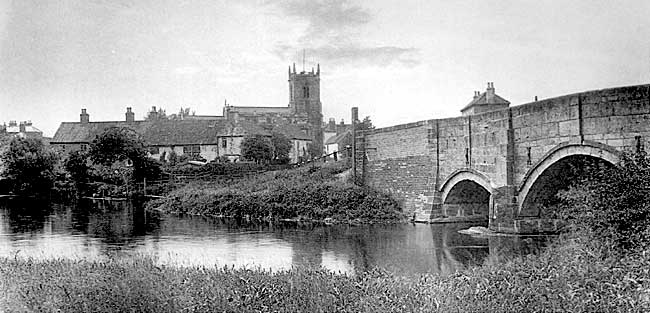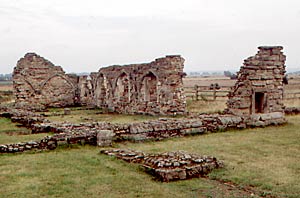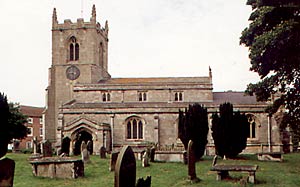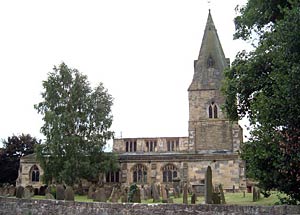< Previous | Contents | Next >
With the Idle Passing By

Mattersey in the early 1900s.
MATTERSEY. It looks its loveliest from the fine little bridge carrying the road over the Idle, a picture of red and grey walls gathered round a venerable church.

Mattersey Priory in 2000.
The narrow bridge of three round arches, still showing mason's marks, is said to have been built by the monks of Mattersey Priory, founded in 1185. The only house of the Gilbertine order in the county, its ruins are at the end of a mile-long lane, in a delightful spot where the river swings sharply round in the meadows. In picturesque company with a farmhouse built partly with the stone of the monastery, the whole of the ground plan is laid bare, showing the buildings outlined in grey stone round the four sides of the cloister. There are parts of two walls of the refectory, a corner of a medieval tower or chapel which stood north of the small church, the bases of two altars, and several coffin stones.

Mattersey church in 2000.
Mattersey church was given to the priory in 1280. Its 15th century tower, with eight gargoyles of ugly little men, stands partly in the nave, and its narrow arch rests on the heads of a boy and a girl. In the sculpture gallery adorning the north wall of the church outside are three gorilla-like gargoyles on brackets, and heads of human folk, grotesques, and a dog with long ears are on the hoods of the windows and the old doorway.
The nave arcades, with deep-pointed arches on short pillars, come from the end of the 14th century. Older still is the fine little chancel arcade of two bays with nail-head on the capitals and the letter A on a pillar; it is the initial of John Acklom, who repaired the chancel. The lovely 15th century east window of the chapel has blue and yellow fragments of old glass. A window showing live soldiers looking up to Our Lord holding a jewelled crown is to 19 men who did not come back, three of them brothers. The south aisle has a founder's recess; the modern font, with elaborate carving of foliage, has an extraordinarily high cover, like a hollow steeple resting on open arcading, crowned by a dove.
Two stone panels set in the walls of the vestry, elaborately carved with figures under canopies, were found under the chancel floor, and are rather battered. In one we see St Martin on horseback sharing his cloak with a beggar, in the other St Helena finding the Cross.
The Wandering Village
MISTERTON. A big, wandering village within two miles of the Trent, it has a fine view of the flat lands known as the Cars, and treasures lovely old work in its church.

Misterton church in 2005.
© Copyright Alison Stamp and licensed for reuse under this Creative Commons Licence
It was lightning in the middle of last century that brought about the church's restoration and rebuilding. The tower was made new in its original 13th century style, and the actual stonework of its windows (with carved hoods) was replaced; the broached spire was added at the same time. Its 13th century arch still opens to the nave, but the glory of the tower is in another arch of that time leading to an aisle. Resting on two splendid corbel brackets carved with flowers and foliage growing from stalks, and framed by a fine hood, it is arresting as we enter the church through a lovely old doorway.
Three fine arcades add to the old array. The 14th century north arcade of the nave has foliage capitals, and two great heads supporting its end arches; one has curled hair, the other has grotesque ears and a beard all round a smiling face. The south arcade comes from the close of the 15th century, the time of the clerestory windows, the chancel arch, and the pillars of the arcade leading to the chancel chapel. These support three horseshoe arches of about 1200, the oldest remains in the church.
The east window with unusual tracery, a piscina with two drains, and the base of the font are medieval. A bell in the tower has an inscription older than the Reformation, saying "Let Gabriel's sweetest voice sound forth Jesus."
An old glass fragment showing a bishop in a blue robe and golden mitre (perhaps St Hugh) may have come from Lincoln. Rich modern glass has the Evangelists, the Annunciation, the Nativity, and the Temple scene with Simeon, Jesus, and Mary, and Joseph. Oswald with a crown, Stephen with stones, and Alban with a sword are in a lovely window to those who died for peace. The names of 22 men and a nurse who gave up their lives are on a cross outside the churchyard. Among seven striking gargoyles looking out from the north wall are grotesque animals with manes, a griffin, and a creatur'e with a bearded face, the body of a bird, and arms ending in claws.
